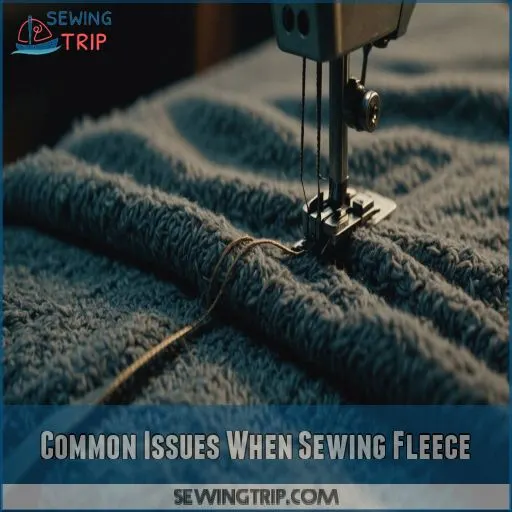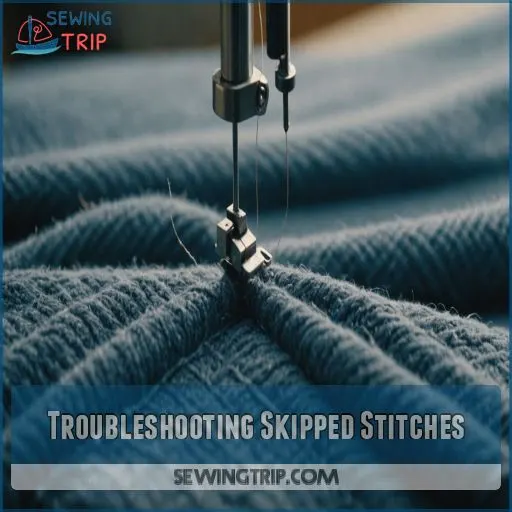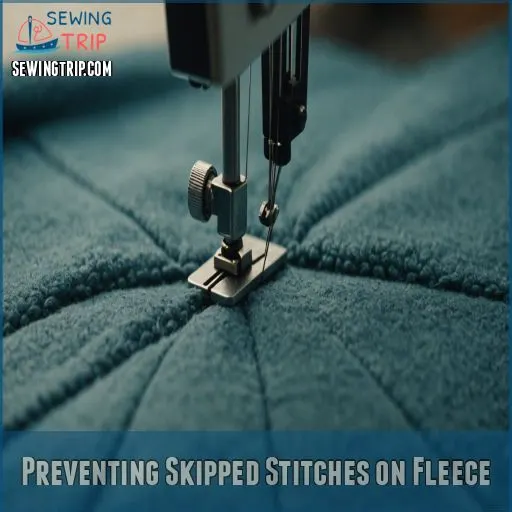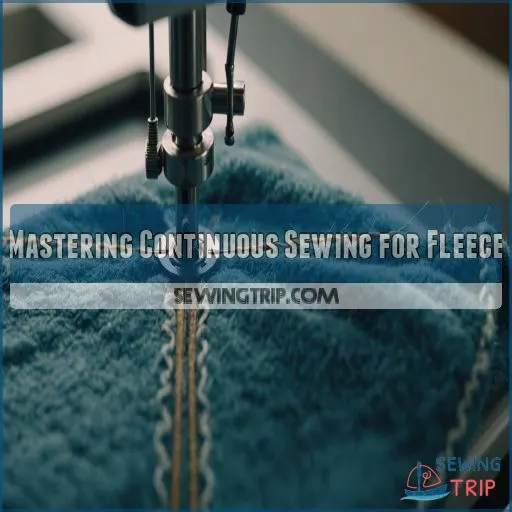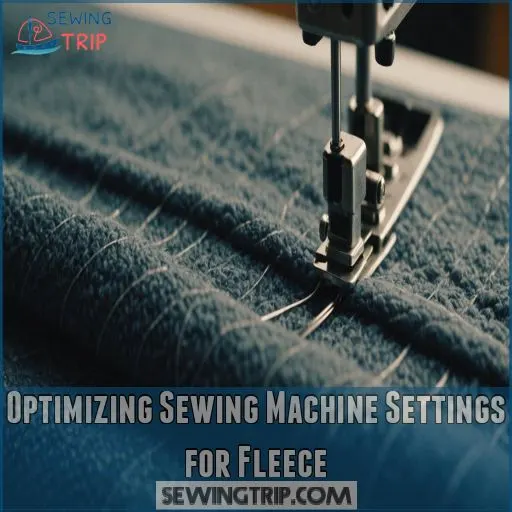This site is supported by our readers. We may earn a commission, at no cost to you, if you purchase through links.
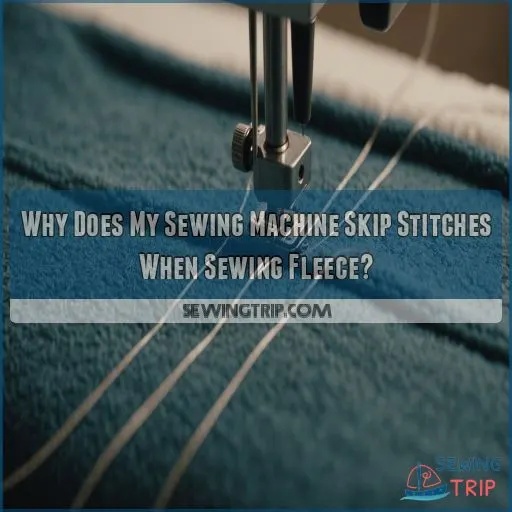 When your sewing machine skips stitches while sewing fleece, it could be playing tricks for a few reasons. Fleece is bulky, causing tension woes.
When your sewing machine skips stitches while sewing fleece, it could be playing tricks for a few reasons. Fleece is bulky, causing tension woes.
Make sure your needle’s sharp—size 90/14 or 100/16 works well. If the tension’s off, threads can start a tug-of-war, leading to skips.
Clean and oil your machine; it’s like flossing but for stitches. Use polyester thread that matches your fleece’s heft. Lighten the presser foot grip to avoid stretch-induced skips.
If your stitches look like they’re vanishing into thin air, explore different needle types and tension tweaks. Who knows, you might just discover your machine’s sweet spot!
Table Of Contents
Key Takeaways
- You’re not imagining things—fleece can be as tricky as a cat in a bathtub when it comes to sewing. It’s bulky and stretchy, which can throw your machine for a loop. But don’t worry, you’ve got this!
- Your needle is your secret weapon. Make sure it’s sharp and the right size (90/14 or 100/16 work well). A dull needle is like trying to cut butter with a spoon—it just won’t work.
- Tension matters more than you think. Too tight, and your threads will be in a tug-of-war. Too loose, and they’ll be as floppy as wet noodles. Play around with your settings until you find that sweet spot.
- Keep your machine happy with regular TLC. Clean out lint (it’s like dental floss for your machine), oil the moving parts, and don’t forget to change your needle regularly. A well-maintained machine is a stitch-happy machine!
Identifying Skipped Stitch Causes
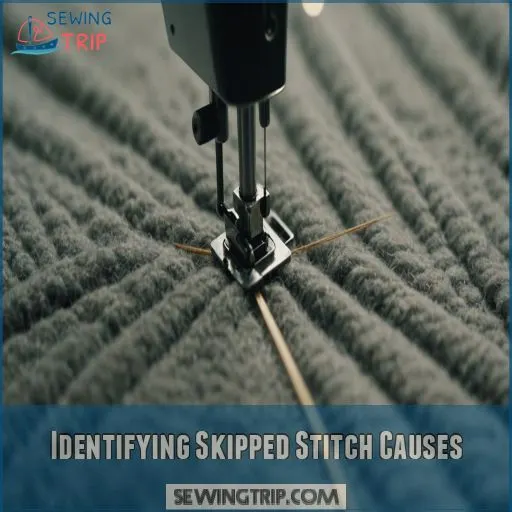
When your trusty sewing machine starts skipping stitches while handling fleece, the reasons can pile up like clothes on laundry day, especially if you’re unsure about the ideal sewing machine stitch length for thick fabrics
.
From using the wrong needle to poor maintenance habits, identifying the root cause will save you from pulling out your hair, whether it is due to incorrect usage or other underlying issues related to skipping stitches.
Incompatible Fabric Types
When your sewing machine skips stitches on fleece, the fabric type might be the culprit. Mix-ups between knit and woven fabrics can cause chaos.
- Fabric Weight: Heavies and lights don’t mix.
- Thread Compatibility: Mismatched fabric and thread leads to skipped stitches.
- Stitch Length: Adjust for fabric density and complexity.
Experiment with settings; mastery awaits!
Incorrect Needle Usage
Your sewing machine may skip stitches when sewing fleece if you’re using the wrong needle.
Try a sharp, high-quality needle designed for thick fabrics, like a size 90/14 or 100/16 universal or stretch needle.
Make sure the needle is fully inserted and secured in the machine.
Dull or bent needles can’t form proper stitches.
Improper Thread Tension
Needle choice isn’t the only stitch stealer—thread tension can make or break your fleece project.
Too loose or tight tension might cause skipped stitches, leaving you puzzled with sewing problems.
Master the art of tension adjustment tips: check top tension issues and bobbin tension impact.
Proper tension troubleshooting is like finding the perfect balance in your morning coffee, it’s all about the perfect balance.
Malfunctioning Sewing Machine Parts
Adjusting thread tension might help, but those skipped stitches could signal malfunctioning parts. It’s like your machine’s having a bad hair day.
Check these likely culprits:
- The bobbin case – Look for lint causing chaos.
- Feed dogs – Inspect for proper movement.
- Needle hook timing – Make sure it’s synchronized for smooth stitching.
Regular sewing machine maintenance saves you headaches!
Inadequate Maintenance
Maintenance is the unsung hero of a well-oiled sewing journey. Ignored upkeep of your machine invites skips like unannounced party crashers. Try sewing machine cleaning regularly. Dust bunnies are not cute here.
Keep lubricating sewing machines, and stick to regular maintenance schedules. For instance, uneven tension in threads can lead to skipped stitches, so make sure the thread tension disk is properly engaged and check your thread path. Additionally, selecting the correct thread weight for the fabric weight is important to prevent skipped stitches.
Embracing preventative maintenance tips can promise less hassle. After all, a stitch in time saves nine!
| Task | Action | Frequency |
|---|---|---|
| Clean Machine | Dust and Lint Removal | After Each Project |
| Oil Machine Parts | Use Sewing Oil | Monthly |
| Check Needle | Change if Bent or Dull | Every Project |
| Inspect Bobbin | Correct Placement | Weekly |
| Professional Tune-Up | Full Service | Annually |
Common Issues When Sewing Fleece
When you’re sewing fleece, you might feel like your sewing machine is just as stubborn as your cat when you try to give it a bath.
The thick, plush fabric often causes issues like skipped stitches, especially if your needle is worn or the motor needs a tune-up.
Bulkiness and Rigidity of Fleece
You’re cruising along with your sewing project, then bam! Fleece’s bulkiness throws a wrench in the works.
This dense, cuddly fabric can trip up your sewing machine like a squirrel in traffic when using the wrong jersey sewing needles
.
It’s essential to choose the right needle and adjust stitch length to glide through seams smoothly.
Taming fleece’s wild side means conquering its fluffy fortress.
Needle Threader Pull and Skipped Stitches
Fleece can trick your sewing machine into skipping stitches faster than you say "needle threader pull, often due to bent sewing machine needles
Consider these tactics:
- Check tension: Tighten or loosen it based on fabric thickness.
- Consider needle type: Swap needles for better compatibility.
- Choose appropriate thread: Match it to fabric needs.
- Use needle threaded properly: Avoid "eek" moments.
It’s time to master perfect fleece hems when sewing
!
Worn or Dirty Needles
Those pesky worn or dirty needles – they can really throw a wrench in your sewing plans, especially when sewing through thick fabrics. Don’t let them get the best of you. Check your needle regularly and replace it if it’s looking worse for wear.
A fresh, clean needle can also help prevent timing issues, which may require professional service if not addressed properly. A fresh, clean needle can really make a world of difference when sewing through that cozy fleece. Trust me, your machine will thank you!
| Needle Condition | Symptoms |
|---|---|
| Worn | Skipped stitches, thread breakage, uneven tension |
| Bent | Skipped stitches, fabric puckering |
| Burrs | Fabric snags, thread breakage |
| Blunt | Fabric damage, skipped stitches |
| Dirty | Skipped stitches, thread breakage |
Weak Motor or Untuned Sewing Machine
Changing that worn needle didn’t solve it? Your motor might be running out of steam!
Sewing machine maintenance is your ace here. A weak motor can mess with your fleece project, making stitches skip like a broken record.
Tuning for smooth stitching is essential. Consider professional tune-ups to troubleshoot motor issues and boost performance.
Troubleshooting Skipped Stitches
When your sewing machine skips stitches while tackling fleece, it can feel like trying to sew a cloud that’s mysteriously allergic to needles.
To tackle this issue, start by checking the thread tension and ensuring the needle is in the right spot.
Then give your machine a good clean, and if all else fails, it might be time to consult a professional.
Checking Thread Tension
When your sewing machine skips stitches on fleece, thread tension might be the culprit.
Imagine it like a dance—too tight or too loose, and the rhythm’s off.
Use tension adjustment tools to balance the upper and lower tension. This tension troubleshooting can stop skipped stitches and get your project grooving smoothly again, avoiding a sewing snafu.
Ensuring Proper Needle Placement
After adjusting thread tension, focus on needle placement. Make sure your needle is correctly placed; it should be fully seated.
Face the right direction, especially when sewing on thick fleece. This will help prevent A can of stitches from forming.
Stick with the right needle size and type for the fabric to ensure a successful sewing adventure.
Cleaning and Lubricating the Sewing Machine
Your sewing machine’s hidden lint traps might be sabotaging your fleece project.
It’s time to grab your cleaning tools and remove those dust bunnies lurking inside.
A bit of lubricant will keep parts gliding smoothly and cut down on skipped stitches.
Clean every few bobbins for best results.
Who knew hygiene could be so crafty?
Seeking Professional Assistance
If cleaning your machine hasn’t worked and skipped stitches persist, it might be time to seek professional assistance.
Finding a reliable technician can save headaches, especially if those furry fleece projects feel more like wrestling an uncooperative cat.
While repairs can sometimes cost a pretty penny, check if your warranty coverage tackles common problems like stitching woes.
Preventing Skipped Stitches on Fleece
Dealing with skipped stitches on fleece? No need to pull your hair out!
The key is keeping a close eye on your needle and regularly re-threading it.
Experiment with different needle types to find the perfect match for your fluffy fabric.
Regular Needle Checks
Skipped stitches got you feeling threadbare? Let’s discuss needle checks.
Pay attention to needle condition, as a worn or bent one won’t play nice with fleece.
Test its sharpness regularly and keep up with needle maintenance. Swap it out if it’s dull.
Choosing the right size and brand can make a tangible difference, sewing smoothly .
Re-threading the Needle
Struggling with skipped stitches? Try re-threading the needle. Sometimes a single misstep in threading can throw the whole project out of whack.
Remember these tips:
- Make sure the thread is in every guide.
- Make sure the tension discs grip the thread well.
- Pull the thread taut before starting.
Give it a go and watch the magic happen!
Experimenting With Different Needle Types
Once you’ve nailed re-threading, it’s time to experiment with different needle types.
Fleece often demands a ballpoint needle—Schmetz and other brands make reliable options. Consider needle size and material too, like a 90/14 size for thicker fleece.
When working with fleece, it’s also important to reduce tension and lower press pressure to the fabric, which can lead to skipped stitches.
To avoid this, handling fleece gently is key.
Testing various needle brands and point types helps find what your machine loves, reducing those pesky skipped stitches.
Mastering Continuous Sewing for Fleece
Ever tried sewing fleece only to hear the dreaded "klunk" as your machine skips a stitch?
By mastering continuous sewing, you’ll keep your tension steady.
Make your stitching smoother, and save yourself the hassle of going back to fix what’s missed with smoother stitching.
Maintaining Consistent Tension
Tackling fleece challenges means understanding tension basics.
Imagine this: your thread’s the tightrope walker, balancing perfectly. Too tight, and it snaps; too loose, and it sags.
Experiment with different thread types and adjust foot pressure and bobbin tension. Keep tension tools handy, and you’re the master of sewing bliss, even if your machine occasionally fusses.
Preventing Skipped Stitches
Maintaining consistent tension can be as tricky as herding cats, but preventing skipped stitches is doable.
Start with a needle selection guide; ballpoint needles work wonders on fleece.
Adjust thread tension tips as needed. Don’t forget regular sewing machine maintenance to avoid gremlins in sewing machine parts.
Who knew mastering fleece fabric types could be this rewarding?
Practicing Continuous Sewing
Don’t let skipped stitches ruin your fleece sewing projects.
The key is practicing continuous sewing – keep that needle moving at a steady pace and you’ll master the technique in no time.
Experiment with different thread tensions and needle types until you find the perfect combo for your machine.
With a little patience, you’ll be sewing fleece like a pro.
Applying the Technique to Other Challenging Fabrics
So, you’ve mastered continuous sewing on fleece, but how about tackling denim or leather?
The techniques apply! Adjust your needle size and thread for heavyweight fabrics.
Silk and canvas demand gentle handling and a sharp needle.
Upholstery? Patience and the right footwork will guide you.
Remember, it’s like taming each fabric’s wild side—challenge accepted!
Optimizing Sewing Machine Settings for Fleece
When your sewing machine throws a tantrum over fleece, it’s time to fine-tune those settings for smoother stitching.
Adjusting presser foot pressure, picking the right needle, and fiddling with tension can feel like a puzzle, but getting it right turns sewing fleece from a hassle to a breeze.
Adjusting Presser Foot Pressure
Continuous sewing sets the stage, but have you checked your presser foot pressure? Too light, and fleece fabric slides around like butter on a hot skillet. Adjust it to keep stitches in line.
Follow these sewing tips:
- Locate the pressure adjustment knob.
- Increase pressure for thicker fabric.
- Test stitches on scrap fleece.
- Fine-tune tension control.
Choosing the Correct Needle
After adjusting the presser foot pressure, it’s time to focus on choosing the right needle for fleece. Your needle’s size, type, sharpness, and condition all influence stitching success.
An 80/12 needle often works well, cutting through fleece like a hot knife through butter.
Check this handy table to match needle specs with fabric thickness:
| Needle Size | Needle Type | Fabric Thickness |
|---|---|---|
| 80/12 | Universal | Light to Medium |
| 90/14 | Ballpoint | Medium to Heavy |
| 100/16 | Sharp | Heavy |
| 75/11 | Stretch | Light Stretchy |
| 90/14 | Denim | Thick Fabrics |
Selecting Better Thread
Choosing the right thread for sewing fleece feels like a hidden art, but here’s the secret sauce:
- Thread types: Opt for polyester, which offers strength and flexibility.
- Thread weight: Medium weight balances strength without bulk.
- Bobbin thread: Match it with your top thread for harmony.
- Thread quality: High-quality threads avoid breakage and skipped stitches. Don’t skimp here!
Adjusting Sewing Machine Tension
Switching threads can work wonders, but adjusting thread tension secrets is your secret weapon for flawless fleece stitching
.
Play with top and bottom tension to find that sweet spot—your ideal tension.
Too tight or loose? That’s a recipe for skipped stitches!
Remember, tension troubleshooting isn’t magic, it’s science with a touch of art—and a sprinkle of patience.
Setting the Ideal Stitch Length and Width
When sewing fleece, the stitch length and width can make a difference.
Try these tips:
- Use longer stitches (3-4mm) to prevent skipping and puckering.
- Increase the stitch width slightly to accommodate the fabric’s thickness.
- Adjust tension as needed – fleece may require looser tension than cotton.
- Experiment with different needle sizes and types to find the best match.
Frequently Asked Questions (FAQs)
Why is my sewing machine skipping stitches?
They say a stitch in time saves nine, but yours might skip due to a dull needle or the wrong one.
Try using a ballpoint or Microtex needle and adjust your thread tension for smoother results.
Why is my sewing machine skipping zigzag stitches?
Your machine skips zigzag stitches often due to incorrect needle choice or tension.
Try a ballpoint or stretch needle, lengthen stitches, and clean lint regularly.
A three-step zigzag stitch might also reduce skipping issues (Source).
What should I do if my sewing machine keeps skipping stitches?
Try rethreading the machine, switching to a fresh needle, and cleaning out any lint around the bobbin area.
Sometimes, just like rebooting a cranky computer, a little maintenance can smooth out those skipped stitches.
Can you sew without skipping a stitch?
Imagine you’re stitching and it’s smooth sailing.
With the right needle (like ballpoint or Microtex), adjusted tension, and steady hand,
you’ll avoid those pesky skips and glide through fabric like a master seamstress.
Why is my sewing machine skipping stitches on fleece?
Skipped stitches can be a real pain, but don’t worry – we’ve got your back!
Try switching to a ballpoint or microtex needle.
Lengthening your stitch, and using a narrow zigzag, can make all the difference.
With a few tweaks, you’ll be sewing fleece like a pro in no time.
What tension should I use when sewing fleece?
Your friend’s sewing project turned disaster because the tension was too tight.
Loosen it when handling fleece for smoother stitching; aim for a medium tension setting.
This helps avoid unnecessary frustration and broken threads (Source).
What setting is best for sewing fleece?
Use a longer stitch length, around 3 to
Opt for a zig-zag or stretch stitch.
Maintain low tension and consider a ballpoint needle to avoid skipped stitches.
Don’t forget to clean your machine regularly.
Why is my sewing machine jumping stitches?
Picture a needle dancing erratically through fabric.
Jumping stitches often stem from dull needles, incorrect tension, or incompatible needle types.
Try a ballpoint or Microtex needle, adjust thread tension, and lengthen your stitch for smoother seams (Source).
It’s like finding the perfect dance partner!
What needle type works best for sewing fleece?
For fleece, stretch or ballpoint needles reign supreme.
They’re designed to glide between fibers, preventing skipped stitches and fabric damage.
Opt for size 80/12 or 90/14, depending on fabric thickness.
A fresh needle is your best friend!
How does thread choice affect stitch quality?
Thread choice can make or break your fleece project.
Quality polyester threads prevent breakage and make sure smooth stitches.
Cheap threads lead to headaches, like a bad diet for your machine.
Choose wisely for great results.
Is a walking foot necessary for sewing fleece?
A walking foot isn’t absolutely necessary, but it’s a game-changer for sewing fleece.
It prevents puckering and shifting by moving the top fabric in sync with the feed dogs.
You’ll wonder how you ever managed without it!
How can I stabilize shifting fleece layers?
Tame those slippery fleece layers with a few tricks up your sleeve.
Use pins or wonder clips to secure edges.
Try a walking foot to keep both layers in check. Lower presser foot pressure for smoother sailing.
Does needle seating impact stitch consistency?
Needle seating is really important for stitch consistency.
You’ll want to make sure your needle’s properly seated and tightened.
A loose needle can cause skipped stitches, turning your fleece project into a frustrating game of connect-the-dots.
Check it regularly!
Conclusion
Taming fleece’s skipped-stitch tango takes practice, but you’ve got this!
Remember, your sewing machine’s not out to get you—it just needs the right moves and a tweak or two.
Experiment with different techniques and settings until you find what works.
Before you know it, you’ll be stitching fleece like a pro, wondering why your sewing machine ever skipped stitches when sewing fleece in the first place.
Your sewing machine needs regular TLC to keep it purring.
Happy sewing, and may your stitches be ever unbroken!

